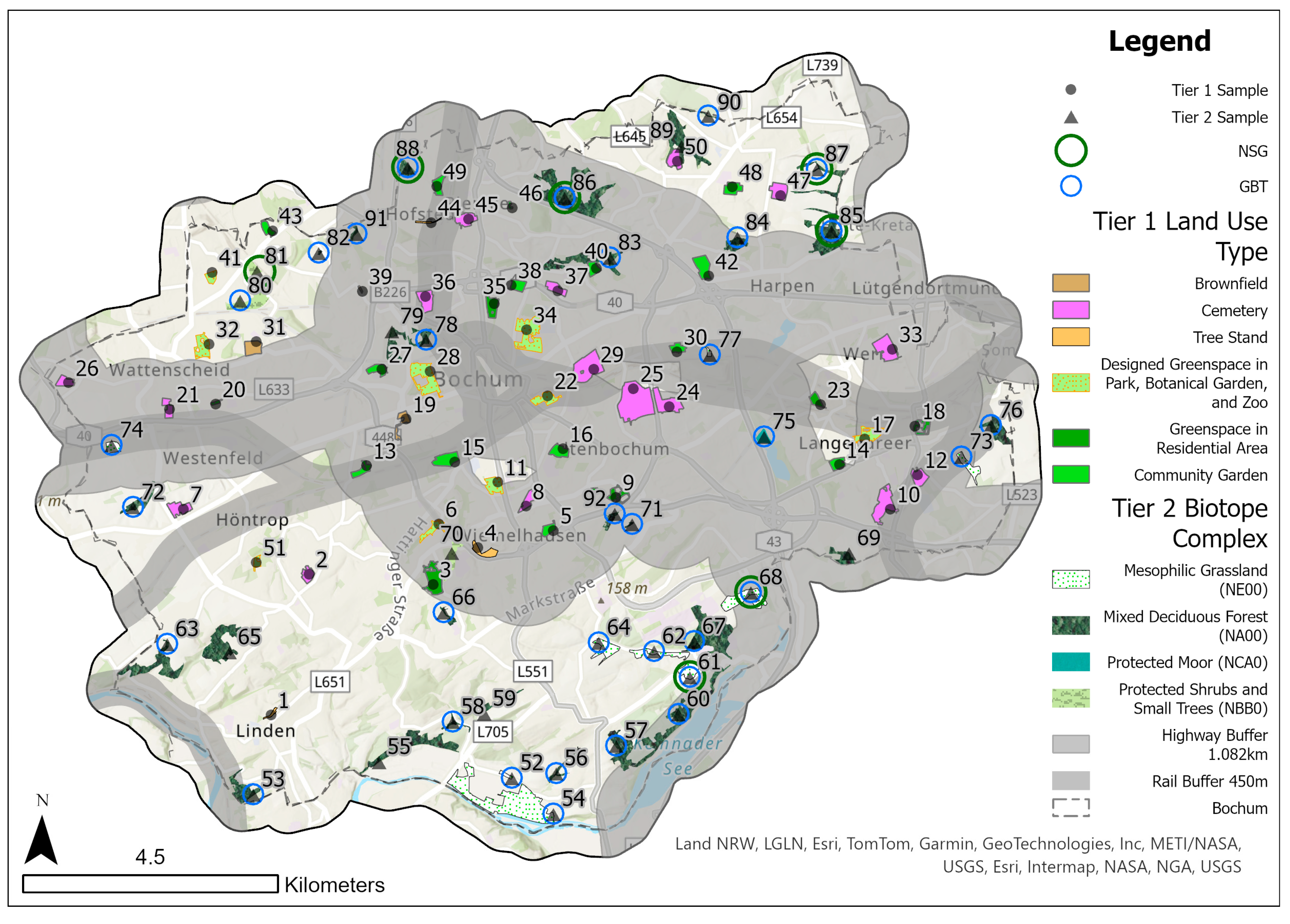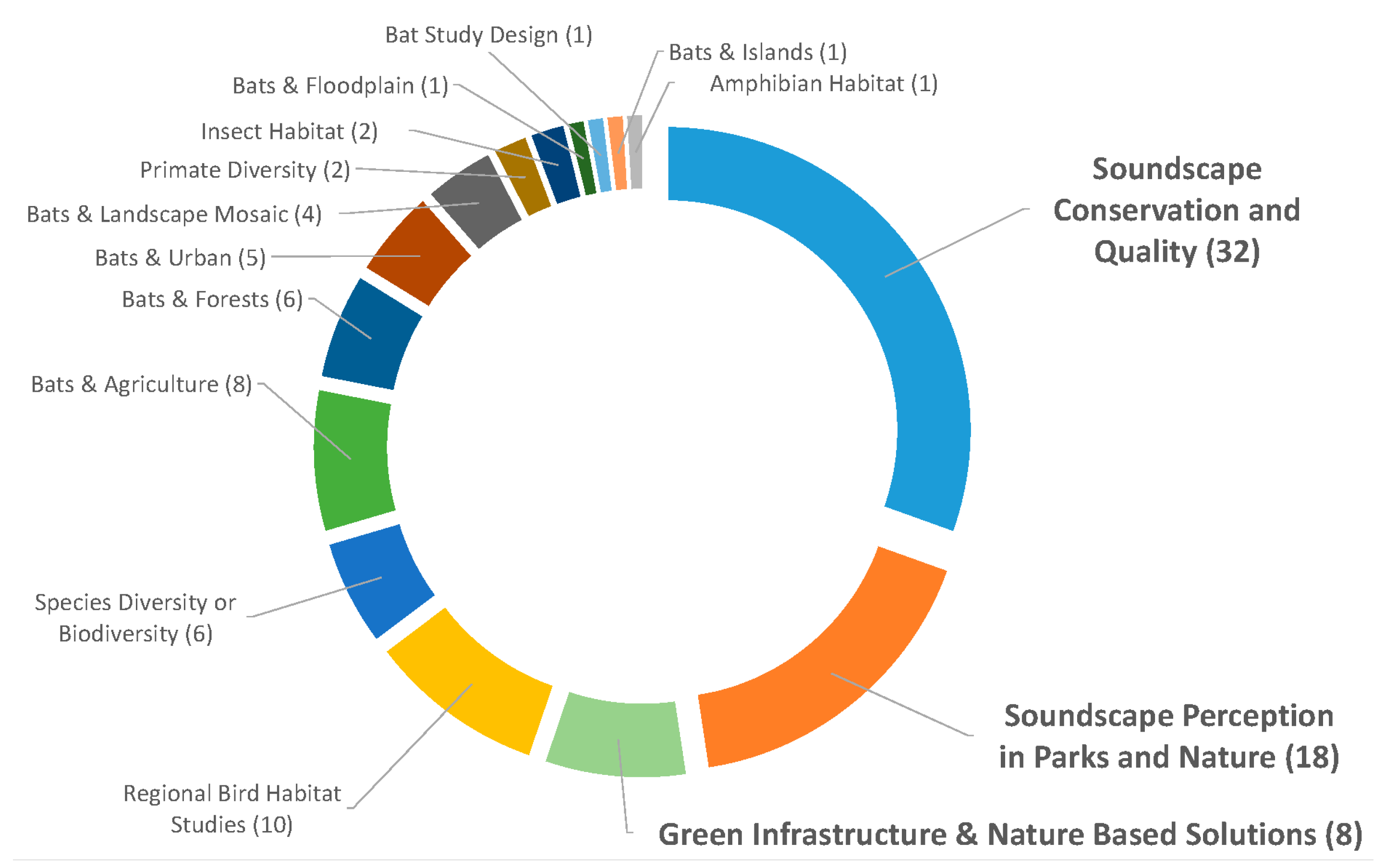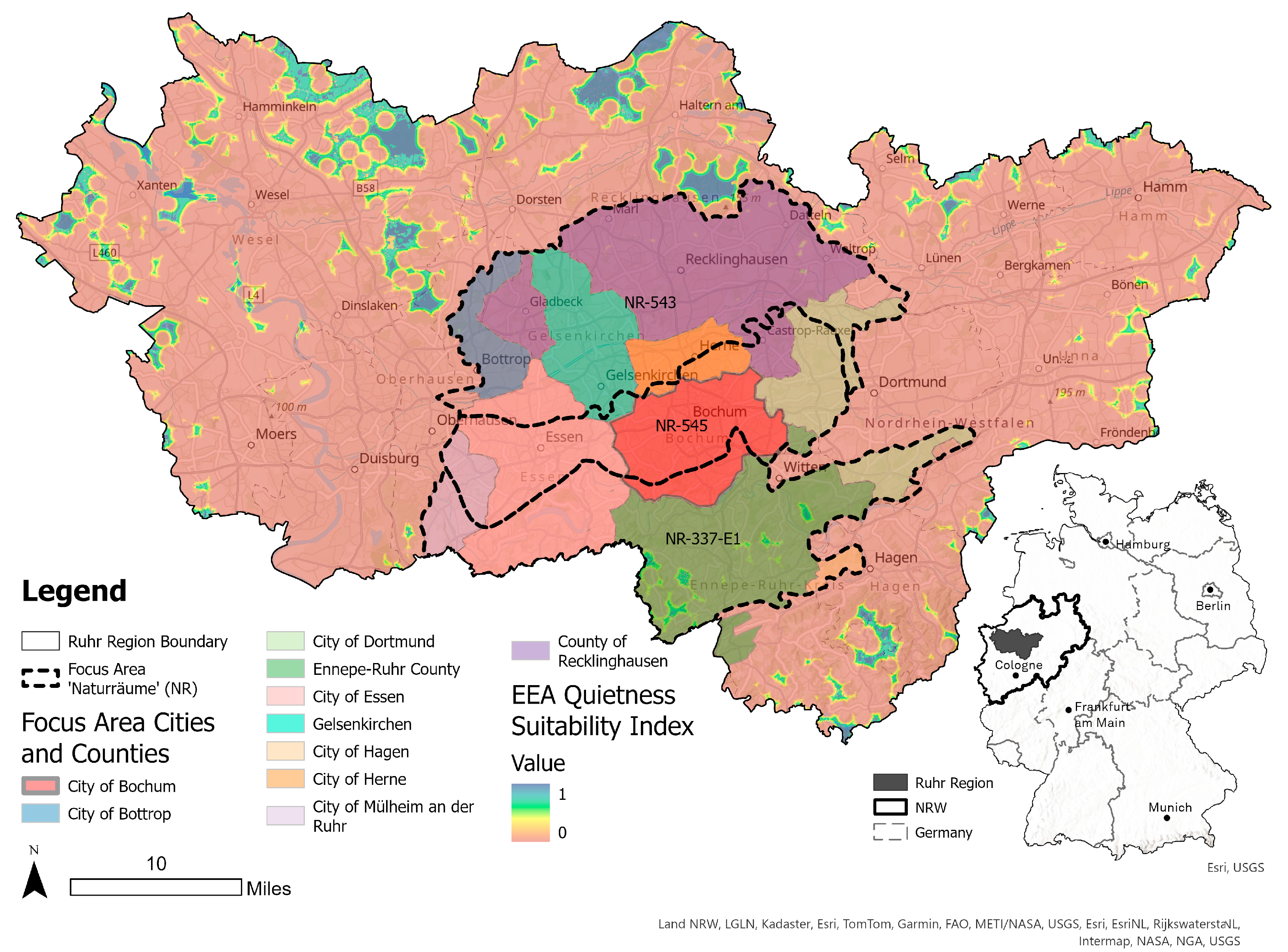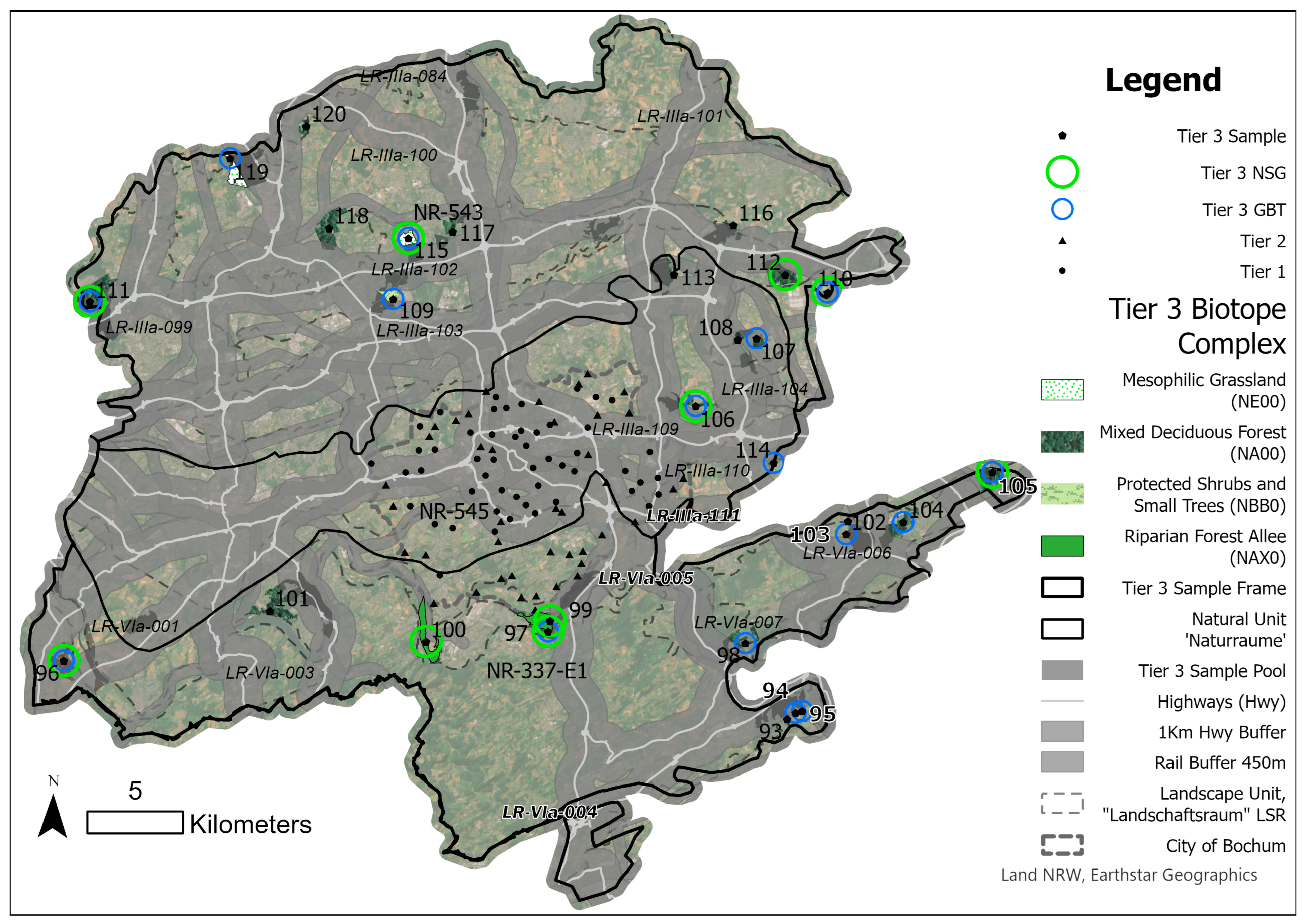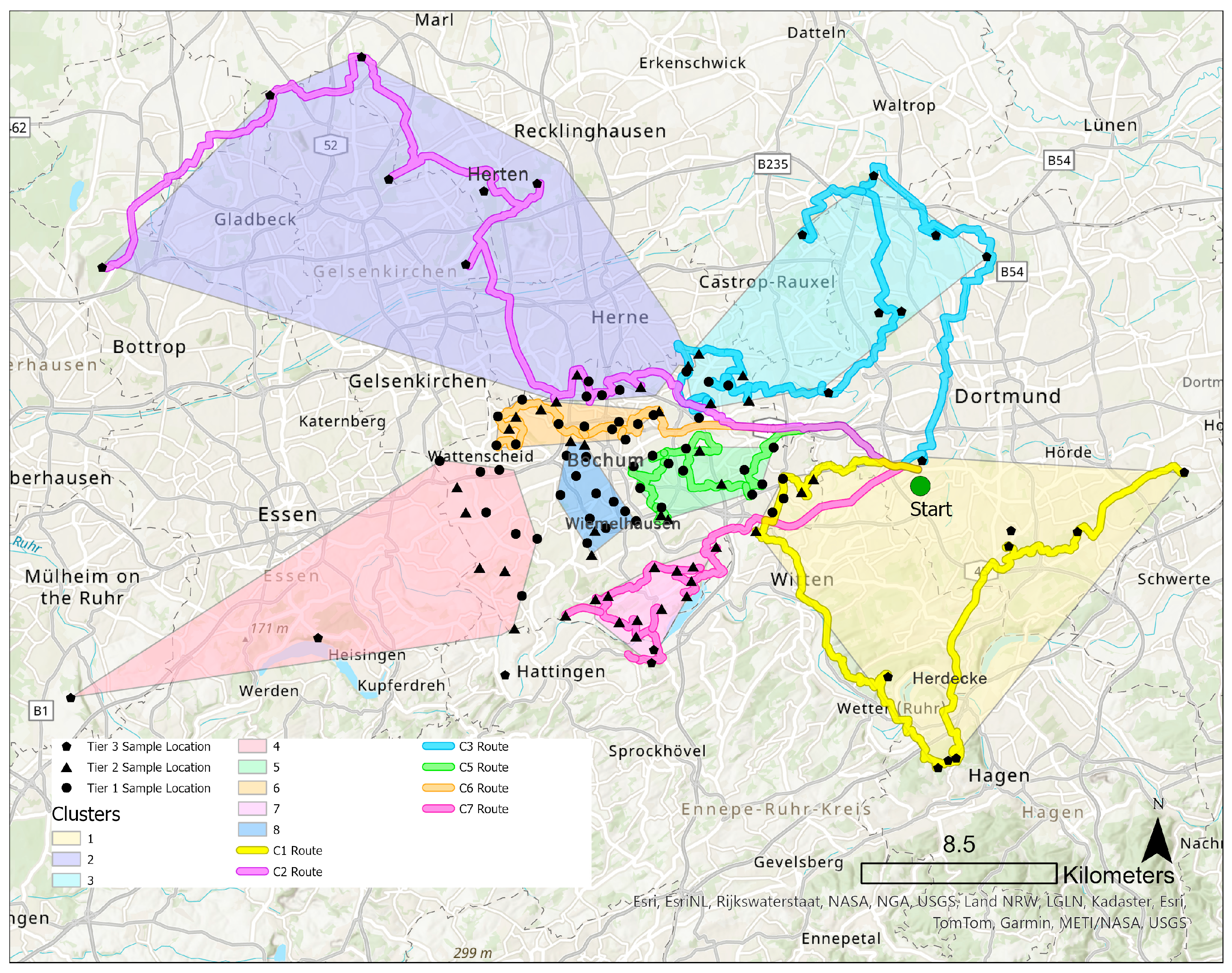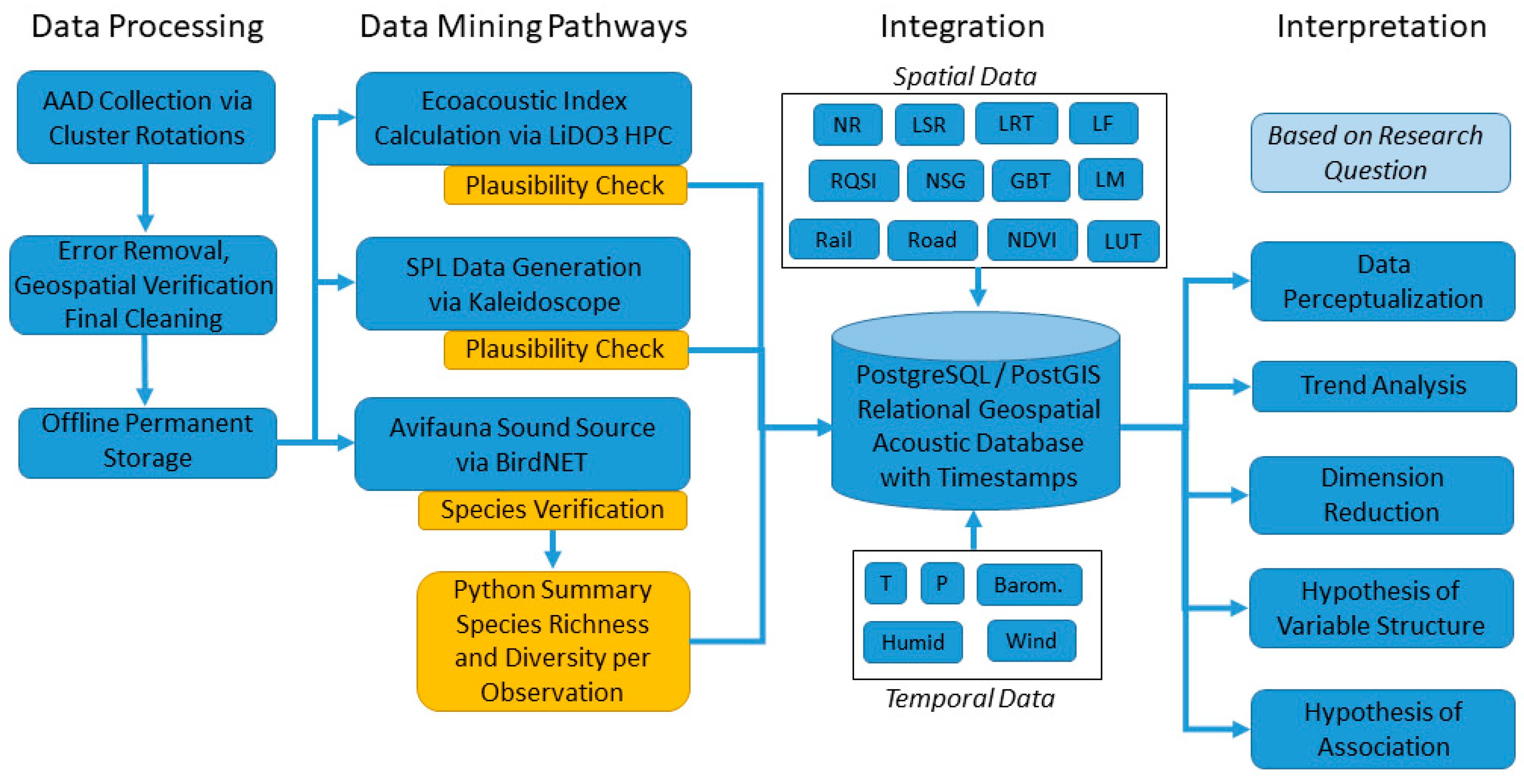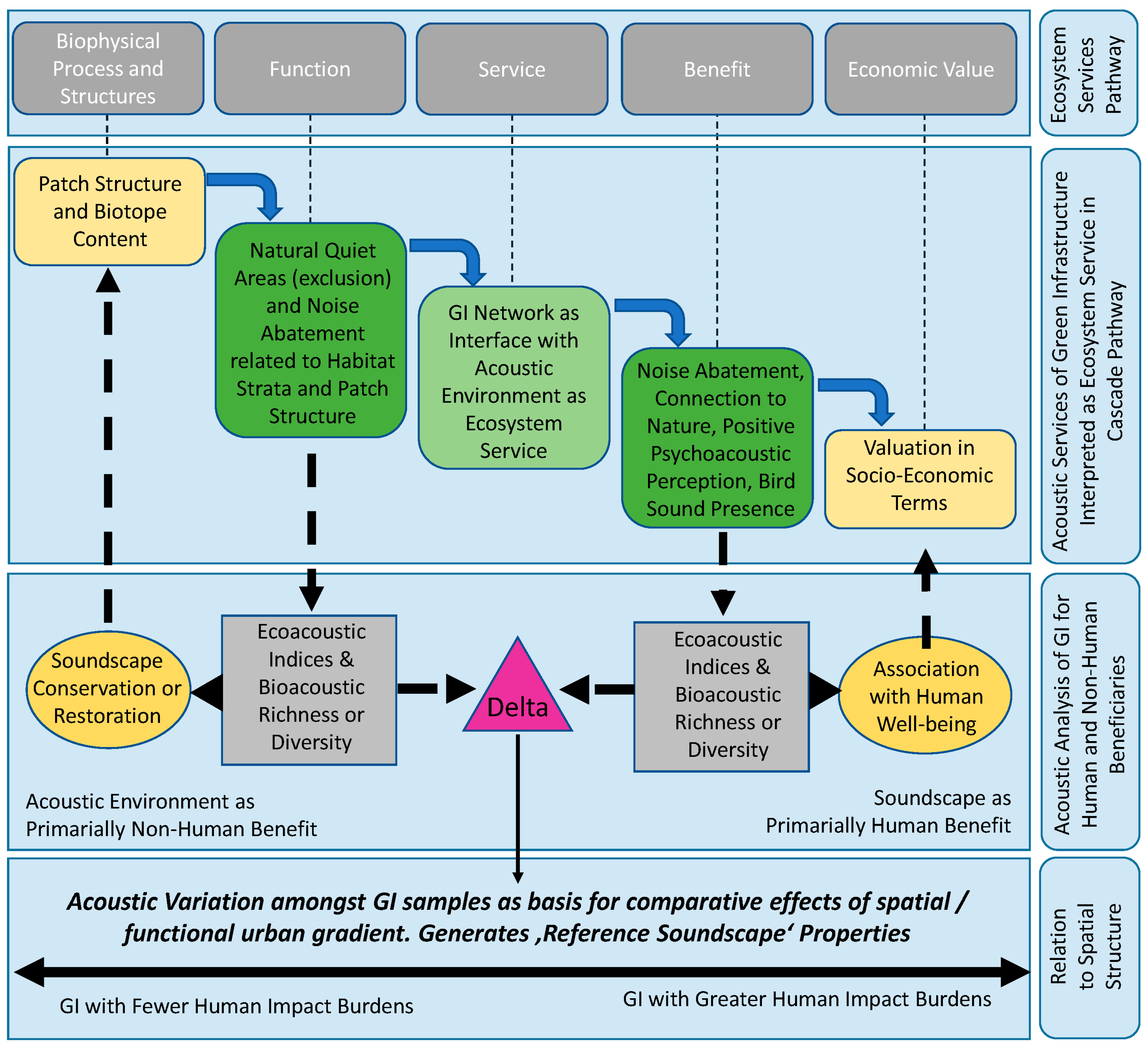In the last decade, the field of soundscape ecology has emerged with an explosion of publications in natural and human environments. According to this paradigm, the soundscape is composed of patches of acoustic environments with homogeneous interactions that arise as sonotopes, interfacing at sonotones, and which exist in a spatially configured sonic context of a soundscape formed by physical interactions between sonotopes [
1]. The soundscape is an analog to the landscape matrix as described by Forman and Godron [
2], where control over dynamics is typically dominated by either human or natural systems, and is the primary background element driving and limiting the evolution of the landscape mosaic. Soundscape ecology is transdisciplinary, containing not only the elements of landscape ecology, but also the investigation of psychoacoustics or human perception [
3], the bioacoustics approach focusing on the link between landscape configuration and biodiversity patterns [
4], and the acoustic ecology perspective linking sound, nature, and human societal constructs [
5]. Soundscape ecology can therefore be subdivided into two primary areas: the study of human-dominated acoustic environments, where human activities exert their influence on the “acoustic matrix”, and the remainder of natural areas, where the bioacoustic mosaic is not directly driven by human landscape modifications or disturbance.
The bioacoustic part of the acoustic environment is of interest as a proxy indicator of biotic activity. Methodologically, the bioacoustic approach identifies vocalizing species assemblages and acoustic communities for use as biodiversity assessments of focused taxonomic groups of indicator species, such as birds, frogs, bats, or insects [
6]. When considering the number of acoustic communities interacting with each other, the community acoustic diversity [
7] acts as a proxy for general species diversity or richness [
8] in terrestrial habitats. However, in the urban and peri-urban environment, acoustic communities must compete not only against each other for acoustic niches in the sound space, but also against an ever-increasing extent of anthrophonic noise.
In the human-dominated acoustic environment, the discussion usually revolves around the control of noise due to the associated negative health outcomes of continual noise exposure on humans, including annoyance and stress [
9], hypertension [
10], myocardial infarction [
11], stroke [
12], atherosclerosis [
13], depression [
14], or the psychoacoustic perception of noise [
15,
16]. The EU Noise Directive [
17] is a response to the burden of human noise exposure in light of growing urban regions. Germany has codified this directive within their spatial planning system as noise action plans [
18] that aim to map the distribution of noise and affected human populations and protect quiet area resources threatened by urban expansion. The quiet area assessment is required as part of the noise action plan, for which best practices have been developed [
19,
20], but in practice there is no biophonic threshold value or reference value to rank quality of quiet areas.
Quiet area planning is also carried out upon the backdrop of land consumption in Germany that can be magnified at the municipal level [
21]. This reality usually means that open spaces and natural areas in proximity to human populations are encroached upon, either physically or by noise emissions. A perfect illustration of the impact of this phenomenon is in Dortmund, Germany, where the extent of potential quiet areas reduced from 2500 ha to 2100 ha between 2014 and 2025 [
22], and the city of Duisburg that allows quiet areas to exceed 55 dB(A). Additionally, the problem is not isolated to just the highly populated Ruhr region; it is found in the USA [
23] and Australia [
24]. Thus, there is compelling evidence that acoustic environments without anthrophonic intrusions are at risk.
1.1. Research Aims
In this study, we aim to summarize the existing concept frameworks for soundscape conservation and sound-related ecosystem services provided by green infrastructure and conservation areas, summarize how this information has been synthesized, conceptualized, or studied by other authors, and come away with what advances are needed in quiet area assessment to better address threats to remaining urban sound quality. To this aim, we conducted a scoping review [
25] following a systematic search approach [
26] with two broad Boolean keyword combinations of (1) “sound* OR acoustic AND landscape OR planning AND conservation OR preservation OR cultural AND green* OR vegetation AND NOT perception AND NOT visual”, and (2) ”soundscape conservation AND urban NOT marine”. The search was restricted to research papers and edited books in English, without any temporal constraint, on Scopus. The raw results (n = 309) were screened by title and keyword, excluding papers related to conservation or GI but not the acoustic environment (n = 136), the acoustic environment but not conservation or GI (n = 9), neither conservation nor GI nor the acoustic environment (n = 56), and policy papers not relevant to the effects of GI or conservation on the acoustic environment (n = 6).
The remaining 104 relevant papers addressed aspects of the acoustic environment, soundscape, and conservation or GI. The 104 studies were further refined by title and keyword into the subcategories (
Figure 1) of bats (n = 26), regional bird habitat studies (n = 10), primates (n = 2), insect and frog studies (n = 3), species diversity or biodiversity (n = 5), acoustic environment conservation and quality (n = 31), soundscape perception in parks and natural areas (n = 19), and green infrastructure and nature-based solutions (n = 8).
A summary of the literature review reflects soundscape ecology as described by Farina [
1], containing elements of landscape ecology and the landscape mosaic and its relationship to non-human organisms; the investigation of psychoacoustics or human perception, especially related to urban and peri-urban park areas; the bioacoustics approach, focusing on the link between landscape configuration and biodiversity patterns or impacts on target species; and the acoustic ecology perspective, linking sound, nature, and human societal constructs such as conservation areas. To keep focused on the aims, we conducted full-text reviews on the 58 articles related to “soundscape conservation and quality”, “soundscape perception in parks and natural areas”, and “green infrastructure and nature-based solutions”. We applied snowballing to highly relevant articles, especially related to GI and ecosystem services.
1.2. A Concept Framework for Soundscape Conservation
One of the first frameworks for soundscape conservation [
27] recommends targeting studies based on defined ecosystems, stratified by biotope or species of importance, with measurable management goals and the ability to assess an array of current areas specific to defined threats or objectives. The authors propose the soundscape categories of natural quiet, sensitive, threatened, unique, recreational, representative, cultural, and everyday soundscapes. Emphasis for soundscape conservation should be on high-fidelity, positively perceived soundscapes, which are especially important in human habitats where urbanization threatens a loss of audible connection to the natural world. Here, fidelity refers to the ability to hear what is happening in the immediate acoustic environment.
The US National Park Service (NPS) concludes that natural quiet areas range from 10 to 40 dB(A) for truly wild and natural protected areas. This category is particular for the USA, where huge tracts of truly remote land in the west exist without any human development. Guidance on European quiet areas required by the EU Noise Directive [
17] for urban and peri-urban communities range from 50 to 55 dB(A), at least in the German Ruhr region [
22,
28]. Threatened soundscapes occur where high-fidelity conditions face encroachment from anthrophonic sounds, such as the urban fringe, the edge of large biotope patches, or into nighttime quiet hours. The edge effect of anthrophonic incursion was observed in two recent case studies in Massachusetts, USA and Naples, Italy [
29,
30]. Separate from edge effects, a number of studies have shown that habitat structure or stratification by biotope or conservation area [
24,
31,
32,
33] can influence acoustic environment outcomes. Bormpoudakies et al. [
31] suggest that each habitat type has its own signature with accompanied adaptations. Here, representative soundscapes are a useful concept, serving as indicators for ecosystem or landscape health by measuring bird diversity, a relevant habitat quality measure to rank quiet area quality or thresholds. Our review did not find any studies that proposed “reference soundscapes”, which could be a gap worthy of further study in EU quiet area assessment. Everyday soundscapes connect us to natural diurnal rhythms such as vocalizing organisms. It is a relatable concept to assess GI and biotope networks designed to provide humans with relief from the bustle of the city or serve as biodiversity islands in the urban matrix. Practically speaking, these are the parks and open spaces near our homes used on a regular basis, and even though EEA guidance suggests such spaces can be as small as 1 ha [
19], “urban oases” defined in Dortmund were limited to above 4 ha and isolated to formal urban parks. A network analysis of accessibility to quiet areas in the Dortmund NAP found numerous households not served by quiet areas of 4 ha or greater, illustrating the need for the designation of small “everyday quiet areas” in urban city quarters smaller than 2 ha to fill a spatial gap in quiet area service [
22].
1.3. Green Infrastructure, the Acoustic Environment, and Sound-Related Ecosystem Services
Green infrastructure is “an interconnected network of green spaces that conserve natural ecosystem values and functions and provides associated benefits to human populations [
34]”. Included in this interconnected network are waterways, wetlands, woodlands, wildlife habitats, wilderness areas, and other natural areas and open spaces such as greenways, parks, conservation lands, working farms, ranches, and forests. GI mirrors fundamental landscape ecology principles [
2,
35], where the structure of multi-scalar habitat patches serve as “hubs” to anchor wildlife population origins and destinations connected via corridors or “links” in a landscape mosaic that maintains natural ecological processes and functions [
34]. We must then conclude that the two fundamental purposes of GI are the protection of fundamental ecosystem structure, process, functions, and non-human organisms on one hand and the provisioning of open spaces and ancillary benefits for human health and well-being on the other hand [
36]. In GI networks, these two purposes often have a clear spatial division, with conservation areas generally located in places on the periphery or
in absentia of human habitation, and urban open spaces by definition located within the urban-dominated matrix. This raises the question of how the acoustic environment in GI should be considered within and outside of the urban matrix. For this answer, a more detailed definition of the functions or services of GI is necessary.
The Millennium Ecosystems Assessment expands the notion of GI as the basis for purely ecological processes and functions to “ecosystem services” that create a linkage between ecosystems and human well-being, categorized as provisioning, regulating, cultural, and supporting services that underpin human well-being and poverty reduction [
37]. The German landscape functions approach also includes both an ecological and human systems function to nature protection, including groundwater protection and recharge, water retention and soil moisture availability, the provision of recreation and urban open space, erosion protection and biotic yields, plant and animal habitat and biodiversity conservation, the protection of visual landscape quality, bioclimatological functions such as urban heat island reduction and evapotranspirative cooling, large-scale ambient noise attenuation, and the interconnection of all the above [
38]. Finally, in Haines-Young and Potschin [
39], an integrated concept framework for the ecosystem–human relationship as tiers in a service cascade emerges, where the presence of landscape structure or process preserves an innate landscape function necessary for the management or restoration of ecosystems and biodiversity. When the landscape function serves a purpose beneficial for humans, then it becomes a service that has a social or economic benefit for human well-being in the socio-cultural context. This approach is generally accepted in the scientific community [
40]. To move from a conceptual model to an evaluation model, the cascade of functions can be organized into silos representing physical properties (biophysical structure or process), potential ecosystem offerings (functions), ecosystem services (service), socio-economical uses (benefits), and finally it is the user that assigns a value to the benefit. This organization conveniently depicts the cascade as a sliding scale from the physical–biotic ecological perspective on the left with the primary benefit attributed to non-human species, to the primarily socio-economic value that users assign to a service with a human benefit on the right [
41].
Specific ecosystem services related to sound include the provision of natural quiet or wild soundscapes [
27] that come from remote landscapes and serve the function of noise exclusion [
33]. At the regional scale, greater spatial coverage of noise exclusion or GI areas lead to the function of anthropogenic noise abatement, contributing to county-scale quietness [
33]. The provision of natural sounds can also be considered an ecosystem service of positive human perception [
42], related to what can be called “connection to nature” [
27,
43]. This connection to nature may be facilitated by the presence of bird song, especially in protected areas, thereby enhancing positive soundscape perception [
44] or well-being [
45,
46]. Based on the association of exclusion area and quietness [
33], one could support the broad argument that the ambient quality of the acoustic environment is affected by the extent and composition of GI [
31].
Figure 2 synthesizes ecosystem services in light of sound as a beneficial service for both human and non-human populations, linked via GI. The figure illustrates the ecosystem services pathway [
47] and services cascade [
39,
48], with sound first integrated at the function step, referring to the provision of natural quiet or wild soundscapes or the abatement potential of GI extent. Spatially, these areas can be considered the nodes of resource provision in GI and are most likely related to habitat structure [
29,
31,
49], serving as a relevant feedback for the assessment, planning, and management of open space and conservation areas. In the service step, the acoustic environment has a primarily human benefit interpreted as the soundscape [
50] and is associated with the ecosystem services’ connection to nature, presence of bird sound, positive perception or well-being, and quietness. Here, the relevant soundscape typologies are everyday quiet areas associated with green and open space land uses, usually in the urban matrix, which are the focus of numerous studies found in our literature review [
43,
51,
52,
53,
54,
55,
56,
57]. The comparison of the soundscape between natural quiet areas and their urban counterparts is a pathway towards the generation of reference soundscapes where differences in acoustic community diversity, ecoacoustic indices, and SPL measures are relevant to establishing qualitative benchmarks. Finally, the position of GI amongst the urban matrix, ranging from GI with fewer to greater human impact burdens, is useful to explain acoustic outcomes.
1.4. Soundscape and GI Findings from Relevant Case Studies
Of the 19 case studies described in our literature review, only a few addressed the impact of GI on the acoustic environment. A county-scale analysis in the USA tested the effects of multi-level protected areas (PADUS-GAP), land ownership, and land development potential on average decibels. Conservation levels corresponded to wilderness or wild areas or national parks (GAP 1), conservation areas or scenic areas (GAP 2), state forests (GAP 3), and municipal recreation areas or urban parks (GAP 4) [
33]. Their study found that only the highest level of protection status GAP 1 had a strongly significant positive effect on dB reduction (ß = 0.982,
p < 0.05), and GAP 4 had a strongly significant negative effect on dB reduction (ß = −0.765,
p < 0.05). These findings associate natural quiet areas with the functions of exclusion and abatement to GAP 1 and illustrate the limit to abatement in the GAP 4 results, where anthrophonic incursions from the urban matrix are simply greater than the GI abatement potential.
Another study in the US aimed to understand the association of anthropogenic pressure with the acoustic indices ACI and NDSI, split into constituent biophony and anthrophony frequency ranges [
29]. These results conclude that the human edge was strongly negatively associated with ACI (r = −0.70,
p < 0.05) and biophony range (r = −0.72,
p < 0.05) and strongly positively associated with anthrophony range (r = 0.72,
p < 0.05). ACI and biophony were strongly positively associated with habitat connectivity (r = 0.75,
p < 0.05; r = 0.65,
p < 0.05) and biophony with live vegetation cover as measured by NDVI (r = 0.72,
p < 0.05), whereas anthrophony was moderately or strongly associated with habitat connectivity and NDVI. The results illustrate how proximity to noise sources reduces the overall noise abatement and exclusion services. Notable in this study is the use of a scale effect, summarizing spatial variables in concentric 500 m rings, to measure how the surrounding landscape matrix is exerting influence on a single area. In every case, a scale effect was observable when greater vegetation cover was present at 1.5 and 3 km radii, indicating the importance of exclusion and isolation as a basis for quietness.
A recent study in Australia sought to explain ACI outcomes based on spatial predictors that included vegetation description and patch size, anthropogenic disturbance, physical and hydrological measures, and aspect [
24]. This study concludes that elevation and aspect, along with slope, ridge, distance to creek, and vegetation type, were all ACI predictors. In summary, these studies conclude that the distance from sound sources or scale effects define the overall anthrophonic or biophonic matrix that is then further differentiated based on habitat connectivity, proximity to anthropogenic edge, habitat types and their natural acoustic communities, and general landform factors that control sound distribution over the landscape.
The EEA has proposed a spatial model for EU-wide quiet area identification [
20], the quietness suitability index (QSI). The QSI model is based on a binary fuzzy overlay of buffer zones away from noise sources (1) END major road, rail, and airport locations, (2) urban morphological zones (UMZs), (3) E-PRTR industrial locations, and (4) Corine land cover and land use, including urban, industrial, mined, or construction areas. However, this framework refers only to noise sources and does not include information on how the size and structure of biotope complexes interwoven with noise sources might affect noise abatement performance, or for which areas the connection to nature or psychoacoustic well-being performance might be greater or lesser. A recent German study aims to elaborate a framework for natural soundscape quality assessment [
58], essentially going beyond the EEA QSI to consider cultural ecosystem services and human preferences and well-being, operationalized as vibrancy and calmness. The authors argue that such an approach is a useful incorporation of the positive effects of natural soundscapes in environmental impact assessment (EIA). However, the study bases calmness and vibrancy on spatial factors and does not validate their model with any sound recordings, SPL measures, or soundscape studies of vibrancy and calmness using the DIN ISO 12913 standard [
50]. Nonetheless, the idea of including sound-related ecosystem services in the EIA instrument in Germany has merit and could be argued as an element of “landscape” according to the German Environment Impact Assessment Law (Gesetz über die Umweltverträglichkeitsprüfung) UVPG §2, which includes the element “landscape”. Although landscape up until now had referred to the visual landscape in the German EIA, it may be possible to interpret landscape to include the acoustic environment, or soundscape, as defined by Farina [
1] and Pijanowski [
59].
A recent systematic study on nature-based solutions (NBSs) and human well-being (HWB) in the UK that screened over 7000 studies found only 20 studies associated with the ecosystem services of soundscapes linked to urban green spaces [
60]. The authors conclude that that the relationship between NBSs and HWB is not well understood and to date not thoroughly studied, supporting our conclusion that it is an area requiring further study. One place where such studies could be couched is within the German noise action planning, especially in heavily populated urban agglomerations where anthropogenic pressure is affecting quiet areas, as illustrated in Dortmund [
22]. The EEA has provided guidance on quiet area identification and noted that criteria could include health protection/restoration and perceived acoustic quality and mentions the potential benefits of biodiversity; however, the only method currently elaborated by the EEA is the spatially based source indicator QSI. We argue that a quiet area assessment method aimed at qualifying the bioacoustic and noise abatement properties of GI and assessing where anthrophonic sound sources threaten high-quality quiet areas would be a valuable contribution to the current state of knowledge and necessary for the refinement of German noise action planning.
1.5. Habitat-Based Quiet Area Assessment for Urban Regions
If GI serves as a spatial reserve for critical ecosystem services such as biodiversity, water infiltration, plant community preservation, etc., then we could also expect that GI provides the preservation of naturally quiet acoustic environments, noise abatement of surrounding source pollution, and connection to natural rhythms such as morning and evening chorus, all of which may in turn contribute to human well-being. The use of GI as a framework upon which to analyze the urban–rural gradient will fill the gap in understanding how GI shapes the acoustic environment of urban regions and help to define reference soundscapes for urban soundscape quality. Following the habitat-stratified approaches illustrated by past studies [
24,
31,
61], we argue that quiet area assessment must follow a habitat- and landscape-unit-based sample approach. We propose longitudinal sound measurements in GI types across diverse landscape units, including a range of sizes and types of natural biotopes relevant for noise action planning, recreation infrastructure, protected areas, and brownfields located within varying urban and conservation contexts. The multi-tier PADUS-based soundscape findings in the USA [
33] are relevant to the German context, where nature conservation and biotope databases are stratified by levels of conservation or protection and where protected biotope areas are typically located within larger nature protection areas. Especially important is the potential for improved quiet area assessment frameworks to identify threatened, naturally quiet, and reference soundscapes [
27], indicating that measures of sound pressure, sound source, frequency description, habitat quality, and spatial descriptors must be included. Based on the gap we describe above, improved quiet area assessment methods must address a few broad questions, including:
What is the relationship between green infrastructure and the acoustic environment in urban regions, and how do landscape ecological and green infrastructure factors contribute to sound-related ecosystem service outcomes?
To what degree, if any, can we characterize urban and exurban green infrastructure as providing relief from noise and the anthrophony-dominated urban acoustic environment?
How can this research facilitate integration of threatened, natural quiet, and reference soundscapes into EU or German noise action planning?
